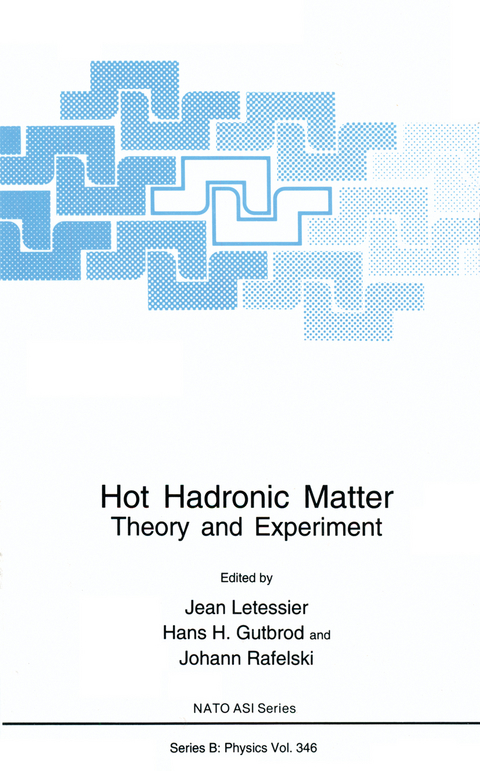
Hot Hadronic Matter
Springer-Verlag New York Inc.
978-1-4613-5798-8 (ISBN)
A Tribute to Rolf Hagedorn.- The Long Way to the Statistical Bootstrap Model.- Entropy for Hadrons.- Statistical Studies of Hadrons.- Hagedorn’s Temperature and the Dual Resonance Model: A 25 Year Old Love Affair.- Mass Spectrum of q-Deformed Dual String Theory.- Hagedorn’s Reincarnation in String Theory.- Interactive Computer Languages: Past and Future of Sigma.- Deconfinement: Concept, Theory, Test.- Hadronic Matter Equation of State and the Hadron Mass Spectrum.- Deconfinement of Constituent Quarks and the Hagedorn Temperature.- Crystalline Quark-Hadron Phase in Neutron Stars.- A New Effective Model of the Quark-Gluon Plasma with Thermal Parton Masses.- Hadronic Matter with Internal Symmetries and its Consequences: An Expanding Hadronic Gas.- On the Statistics-Changing Phase Transition in Gauge Theories.- Fluctuation Corrections to Bubble Nucleation.- A Finite Temperature String Phase Transition a la Volume Exclusion.- Entropy and Decoherence.- Colored Chaos.- Statistical Properties of Relativistic Quasiparticles.- Quantum Decoherence and Entropy in High-Energy Interaction.- Entropy Production via Particle Production.- Real-Time Thermal Corrections to Pair-Production Processes in Heavy-Ion Collisions.- Pions, Baryons and Entropy in Nuclear Collisions.- Entropy in Heavy Ion Collisions.- High Density QCD and Entropy Production at Heavy Ion Colliders.- About Entropy and Thermalization — A Miniworkshop Perspective.- New Developments in Correlation Studies.- How to Investigate Small Collective Signals in Nucleus-Nucleus Interactions.- Negative Binomial Fits to Multiplicity Distributions from Central Collisions of 16O+Cu at 14.6A GeV/c and Intermittency.- Universal Properties of Angular Correlations in QCD Jets.- Towards a Field Theoretical Description ofMultiparticle Production in High Energy Collisions.- Intermittency and Other Scaling Behaviors in Nuclear Collisions.- QCD Generalised Factorial Moments.- Boson Spectra and Correlations in Small Thermalized Systems.- Correlations and Strong Interactions.- Analysis of Multiparticle Correlations and the Wavelet Transform.- Multiparticle Production: Session Summary.- Single Photon Production in 200 A•GeV Sulphur on Gold Collisions.- Latest Results on Dilepton Production in 200 GeV A Ion-Ion Collisions.- Dilepton Spectra in Heavy Ion Collisions.- Photon Multiplicity Measurement, a Novel Observable in High Energy Heavy Ion Collision.- Density Modification of Dilepton Production in Hot Hadronic Matter.- Miniworkshop on Strangeness.- Similarities and Differences in Strangeness Production at BNL and CERN.- Particle Spectra.- Pion and Kaon Freezeout in NA44.- The Dual Parton Model and Hadron Production at Cosmic Ray Energies.- Particle Production at the AGS.- Chemical Equilibrium and Particle Production in Nucleus-Nucleus Collisions at AGS Energy.- Measurement of the ?/? Production Ratio in Central S-W Interactions at 200 A GeV/c.- NA36 Strangeness Production: Multistrange Baryons.- Estimates of the Ratios $$/overline /Lambda //Lambda ,/overline /Xi //Xi$$ and $$/overline /Omega //Omega$$ from pp and pA Interactions.- Thermalisation in High Energy Heavy Ion Collisions and Strange Particle Production.- Strangeness in Hot Hadronic Matter.- Hadronic Physics: The Cosmic Ray Perspective.- Minimax: Progress and Plans.- Event by Event Analysis of Ultrarelativistic Nuclear Collisions: A New Method to Search for Critical Fluctuations.- Observing Strangeness (and Charm?) in Heavy Ion Interactions.- The Physics and Experimental Program of the Relativistic Heavy Ion Collider(RHIC).- Heavy Ion Physics at the Large Hadron Collider at CERN.- The Hadronic Future.- Contributors.
| Erscheint lt. Verlag | 23.12.2011 |
|---|---|
| Reihe/Serie | NATO Science Series: B ; 346 |
| Zusatzinfo | 78 Illustrations, black and white; 574 p. 78 illus. |
| Verlagsort | New York, NY |
| Sprache | englisch |
| Maße | 178 x 254 mm |
| Themenwelt | Naturwissenschaften ► Physik / Astronomie ► Atom- / Kern- / Molekularphysik |
| Naturwissenschaften ► Physik / Astronomie ► Mechanik | |
| ISBN-10 | 1-4613-5798-5 / 1461357985 |
| ISBN-13 | 978-1-4613-5798-8 / 9781461357988 |
| Zustand | Neuware |
| Informationen gemäß Produktsicherheitsverordnung (GPSR) | |
| Haben Sie eine Frage zum Produkt? |
aus dem Bereich


